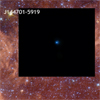CXC Home | Search | Help | Image Use Policy | Latest Images | Privacy | Accessibility | Glossary | Q&A
Tour of Massive Stars in the Milky Way
Quicktime MPEG
Like looking for Easter eggs in a lawn of long grass, the hunt for the Milky Way's most massive stars takes persistence and sharp eyes and powerful telescopes that can see different types of light. This image shows infrared data from the Spitzer Space Telescope near the plane of the Milky Way galaxy. These boxes contain a darkened view of the Spitzer data that highlights a bright Chandra X-ray source. Analysis of the X-ray and infrared data, as well as optical and radio observations, reveals that these bright sources are extremely massive stars. In fact, these stars are thought to be at least 25 times as massive as our Sun. It is difficult to find these stars with optical telescopes because dust and gas in the plane of the Milky Way blocks our view. We can see them in X-rays because high-speed winds from their surfaces collide with material, creating shock waves that generate temperatures up to 100 million degrees..
[Runtime: 01:07]
Quicktime MPEG
Like looking for Easter eggs in a lawn of long grass, the hunt for the Milky Way's most massive stars takes persistence and sharp eyes and powerful telescopes that can see different types of light. This image shows infrared data from the Spitzer Space Telescope near the plane of the Milky Way galaxy. These boxes contain a darkened view of the Spitzer data that highlights a bright Chandra X-ray source. Analysis of the X-ray and infrared data, as well as optical and radio observations, reveals that these bright sources are extremely massive stars. In fact, these stars are thought to be at least 25 times as massive as our Sun. It is difficult to find these stars with optical telescopes because dust and gas in the plane of the Milky Way blocks our view. We can see them in X-rays because high-speed winds from their surfaces collide with material, creating shock waves that generate temperatures up to 100 million degrees..
[Runtime: 01:07]
(Credit: X-ray: NASA/U. of Sydney/G.Anderson et al; IR: NASA/JPL-Caltech)
Images of J144547-5931 and J144701-5919
Quicktime MPEG
Data from Chandra and Spitzer of a region near the Galactic plane have been combined to track down some of the Milky Way's heaviest stars, which can be very elusive. The outlined boxes contain darkened Spitzer data and a bright Chandra X-ray source (blue) that coincides with a strong infrared signal. These are giant stars thought to be at least 25 times more massive than the Sun. They are very bright in X-rays because high-speed winds from their surfaces collide with material, creating shock waves that generate temperatures up to 100 million degrees.
[Runtime: 00:23]
Quicktime MPEG
Data from Chandra and Spitzer of a region near the Galactic plane have been combined to track down some of the Milky Way's heaviest stars, which can be very elusive. The outlined boxes contain darkened Spitzer data and a bright Chandra X-ray source (blue) that coincides with a strong infrared signal. These are giant stars thought to be at least 25 times more massive than the Sun. They are very bright in X-rays because high-speed winds from their surfaces collide with material, creating shock waves that generate temperatures up to 100 million degrees.
[Runtime: 00:23]
(Credit: X-ray: NASA/U. of Sydney/G.Anderson et al; IR: NASA/JPL-Caltech)
Return to J144547-5931 and J144701-5919 (April 13, 2011)




